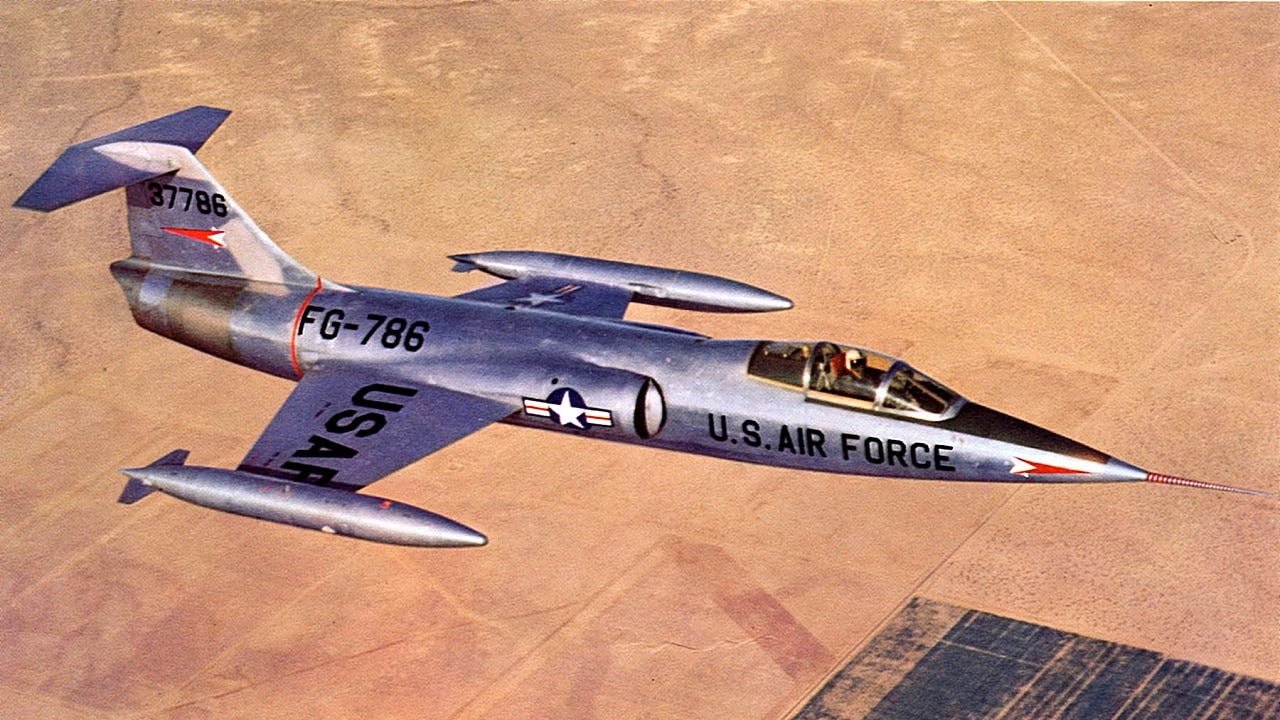The Lockheed F-104 Starfighter was a supersonic interceptor jet that flew in the U.S. Air Force beginning in the 1950s. The F-104 was designed to reach high speeds and climb to high altitudes to chase and shoot down Soviet bombers. Beyond the Starfighter’s emphasis on speed and climb performance, it was also notably small.
The F-104’s defining external characteristics were its needle-like fuselage and razor-thin, stubby wings placed farther back than on most aircraft. This build improved its performance at supersonic speeds by minimizing drag and facilitating acceleration. General Electric’s J79 turbojet engine powered the small aircraft. This would prove to be something of a problem.
The Starfighter excelled as an intercepting aircraft thanks to its high climb speeds, but that attribute came at a significant cost. At lower speeds, the jet’s small wings gave the aircraft little lift. This complicated takeoff and landing, which meant that long runways were needed to accommodate the F-104’s long takeoffs. The jet also made very wide turns, which led to quips from pilots about its large turn radius.
F-104 Starfighter: A Deadly Plane to Fly
The F-104 was a success. It was one of the fastest, highest-flying fighters of its time. But the Starfighter, capable though it was, was a deadly fighter for the American pilots that flew it. The high-speed fighters also experienced problems with other countries’ air forces, particularly when flown by European pilots.
“In 1959, the German Ministry of Defense selected the F-104G as the standard fighter plane for the German Air Force. Its deployment as a fighter bomber, interceptor and reconnaissance plane in poor weather conditions and in ground-level flying necessitated extensive modification of the equipment and airframe structure,” one German museum explains.
In German service, with the Luftwaffe, the Starfighter was deadly—to its own pilots.
“Of the 916 Starfighters flown by the German air force from 1960 until 1987 around one third was lost in accidents. A series of crashes cast a shadow over the introduction of the plane. 269 machines crashed, killing 116 pilots. Technical and logistics problems during the introduction of the complex aircraft system were the source of the initially high accident rate.”
Innovations
The aircraft may have been dangerous to fly, but it was also innovative. Initially, Lockheed engineers designed the F-104 with a downward-firing pilot ejection seat so pilots could avoid colliding with the jet’s tall tail. This was later replaced by a conventional, upward-firing ejection seat, as being shot downward at low altitude posed a significant hazard to pilots.
Ultimately, around 300 Starfighters joined the fleet of the U.S. Air Force. The jet also enjoyed success overseas, where more than 1,700 F-104s served with the Canadian, Italian, Norwegian, Dutch, Belgian, Danish, Greek, Turkish, Spanish, Taiwanese, and Japanese air forces.
Controversies and Scandals
The F-104 was the centerpiece of a significant bribery scandal in the 1960s, when the Starfighter’s developer, Lockheed, was accused of paying out millions of dollars in bribes to secure contracts with a number of foreign countries. The political fallout led to a number of resignations, as well as closer examination of procurement processes in the United States and abroad.
Service with NASA
NASA took advantage of the F-104’s high speed to use it as a platform throughout the 1990s to research various aerospace technologies and space programs. Thanks to the plane’s high-G maneuvers, astronauts trained on the jet to prepare for the rigors of space. Additionally, the Starfighter aided the X-15 program, a NASA hypersonic research aircraft, and with the high-speed space shuttle landings. It also provided valuable insights into the thermal tiles that protected the space shuttle while reentering the Earth’s atmosphere.
A number of photos of the Starfighter in NASA service can be seen here.
Gradual Replacement of F-104 Starfighter
By the 1970s, advancements in jet engine technology and fighter design meant the 1950s-era Starfighter was obsolete. Newer aircraft like the F-4 Phantom II as well as the F-16 Fighting Falcon — still in wide service around the world today — offered better maneuverability, superior range, and a vast increase in payload capacity despite a slower maximum speed and climb rate.
Additionally, the maturity of intercontinental ballistic missile technology meant that large massed bomber fleets, a vital aspect of the Second World War, wouldn’t necessarily be the primary delivery platform for nuclear weapons. This somewhat negated the Starfighter’s mission.
Ultimately, the United States Air Force retired the Starfighter in 1975, though it did remain in service in the air forces of other countries: Italy didn’t retire its F-104s until 2004.
A Poor Safety Record Overall for the F-104
The F-104 Starfighter opened a new chapter in American aviation history. Its mind-numbingly fast speeds and incredible attitude climbs would have posed a grave threat to Soviet bomber formations had they flown en masse against targets in the United States, Europe, or elsewhere.

Lockheed XF-104 (S/N 53-7786) in flight. This aircraft crashed on 11 July 1957 due to uncontrollable tail flutter. The pilot, Bill Park, ejected safely.
In its time, it quite literally pushed the envelope of what was possible — but at the same time, its poor safety track record made it one of the most notorious jet aircraft of the Cold War era.
About the Author: Caleb Larson
Caleb Larson is an American multiformat journalist based in Berlin, Germany. His work covers the intersection of conflict and society, focusing on American foreign policy and European security. He has reported from Germany, Russia, and the United States. Most recently, he covered the war in Ukraine, reporting extensively on the war’s shifting battle lines from Donbas and writing on the war’s civilian and humanitarian toll. Previously, he worked as a Defense Reporter for POLITICO Europe. You can follow his latest work on X.

